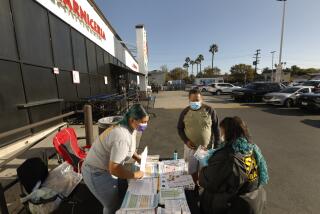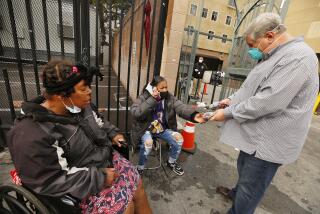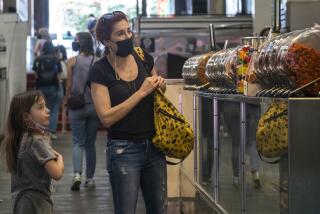L.A. County stay-at-home order could last into summer; more social distancing essential, officials say

- Share via
Los Angeles County health officials warned Friday that the region needs to significantly increase social distancing to slow the spread of the novel coronavirus and that stay-at-home restrictions could remain into the summer.
Even with the dramatic social distancing the county is now seeing, officials forecast that up to 30% of residents could be infected by mid-summer without more behavioral changes, such as reducing shopping trips.
As a result, Los Angeles County is extending the stay-at-home order for California’s most populous county through at least May 15.
Officials could not provide a definitive answer as to when the stay-at-home order will ease.
“Everybody wishes we could answer that and answer it definitively, and we can’t. We do know that we will reopen,” said Barbara Ferrer, director of the Los Angeles County Department of Public Health. “We do know that we will be lifting some of the restrictions and we do hope that we’re able to take a hard look this summer at what makes sense for us to be relaxing, in terms of some of the closures right now that are making it impossible, for example, for some people to get back to work. But it really does depend on the data.”
These are some of the unusual new scenes across the Southland during the coronavirus outbreak.
While the strict physical distancing measures in L.A. County, which have been in effect for three weeks, have clearly had an effect in saving many lives, models presented by the county Friday show troubling forecasts if officials lifted the stay-at-home order now.
There are still too many people becoming infected with the coronavirus in Los Angeles County, officials said. And there is more than a 50% chance that the current capacity of intensive care unit beds in Los Angeles County, roughly 750 beds now, could be exhausted by late April.
“There’s a greater than 50% chance that if we did nothing to increase the number of ICU beds in the county relative to our normal footprint that we would run out of ICU beds near the end of April, or the beginning of May,” said Dr. Roger Lewis, a biostatistician and chairman of the emergency medicine department at Harbor-UCLA Medical Center. Work is underway to increase the county’s ICU bed capacity.
Officials outlined the stark paths ahead for Los Angeles County. If the stay-at-home order was quickly rescinded and people resumed their normal habits, an astonishing 95.6% of L.A. County residents would be infected with the coronavirus by Aug. 1, according to projections released by the county.
Staying at the current levels of physical distancing would still result in 29.8% of residents being infected by Aug. 1.
But increasing our efforts to stay apart from one another by one-third could reduce that to just 5.5% of Los Angeles County residents being infected by Aug. 1.
Put another way: Junking the stay-at-home order now would result in 18,000 people needing hospitalization in L.A. County by mid-May, in a county with fewer than 4,000 hospital beds. But maintaining the current level of physical distancing would keep the number of those needing hospitalization under 1,000 by late May, and the number would be significantly lower if we improved our physical distancing.
Officials cautioned that the forecasts will change over time as more data are fed into them. But the data indicate that now is not the time to let up on the stay-at-home order, they said.
“Physical distancing is working. It has worked to date, and it is working now, and it is important that that physical distancing remain in place in order to reduce not just the strain on the hospital system, but more importantly the overall number of infections,” said Dr. Christina Ghaly, director of the L.A. County Department of Health Services. “It is absolutely the single most important weapon that we have in our arsenal to fight the virus.”
Still, Ghaly said, there are more infections being found every day. On Friday, there were 469 new cases of infection and 19 new deaths reported, putting the cumulative total for Los Angeles County at 8,453 cases and 244 deaths.
“Each person with the infection is still infecting more than one person,” Ghaly said. As long as that happens, the trajectory of coronavirus cases will continue to slope upward.
Even just improving physical distancing by one-third of our current efforts will have a dramatic effect, officials said. Officials are not contemplating new broad-based mandates to close down even more sectors of our society — local authorities across California have already said they think they’ve largely done all they can without shutting down essential sectors.
But residents can do better. Officials will be looking to see whether a new county order announced Friday requiring the wearing of cloth face coverings at essential businesses will help. And residents who continue to go to the supermarket every day are being urged to cut back on going out.
“For many people the routine is like, ‘Well, I can still go to the grocery store,’ and I get that ... but we’re really telling people, ‘No, be very sensible: Limit the amount of time that you’re out and about with other people, even to do those essential purchases,’” Ferrer said.
“We’re not talking about some dramatic new set of measures and opportunities to even further close down wholesale parts of our lives,” Ferrer added. “We have a lot of that in place. We just are all going to do a better job trying to stay safe, stay home, protect each other and keep our distance.”
Based on current data from the county and other communities, roughly 3% of people with COVID-19 require hospitalization. One-third of those patients, or 1% of total cases, will end up in the ICU. The majority of those in intensive care need to be put on a ventilator.
Officials said there are significant activities going on now to increase the total ICU bed capacity in the county, including opening a previously closed hospital and relying on the Navy hospital ship Mercy to take non-COVID-19 patients into its intensive care facilities.
Authorities are optimistic they can increase the number of ICU beds in the coming weeks to meet projected demand. An additional 400 to 500 ICU beds may be needed even if residents continue to physically distance themselves as they have been in the last three weeks, and “I do believe that is a gap we can close,” Ghaly said.
The Mercy, docked in the L.A. area, adds 80 ICU beds; the Los Angeles Surge Hospital, where the shuttered St. Vincent Medical Center campus sits, has 266 beds, a large number of which can be converted into ICU beds; four of the county hospitals run by the Department of Health Services are looking at adding 100 to 150 ICU beds; and the county is working with privately owned hospitals to boost intensive care unit capacity.
Ferrer said she wished she could give a definitive answer when the stay-at-home order can be lifted.
“If the healthcare system can’t stay functional, you also will have a lot of increased mortality from other people who will die of other diseases and conditions as well,” Ferrer said. “At the point we start seeing some serious significant declines in both the rate of new cases and the rate of deaths, we can talk about what’s a reasonable way to particularly get people back to work.”
More to Read
Sign up for Essential California
The most important California stories and recommendations in your inbox every morning.
You may occasionally receive promotional content from the Los Angeles Times.














